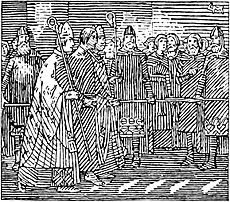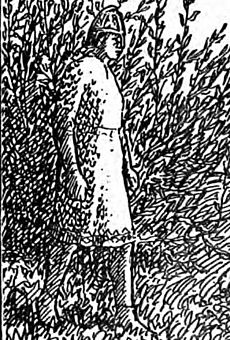Bjaðǫk facts for kids
Bjaðǫk was a woman from the 1100s. She is believed to be the mother of Eysteinn Haraldsson, who became a king of Norway. In the early 1100s, Eysteinn came to Norway. He claimed to be the son of the previous king, Haraldr gilli. Haraldr gilli himself was the son of a woman from a Gaelic background. He also claimed to be the son of an earlier king.
The claims of Bjaðǫk and Eysteinn were accepted. Eysteinn then ruled as king for fifteen years. Bjaðǫk's name might be an Old Norse version of a Gaelic name. She may have come from an important family. Some modern stories say Haraldr gilli's wife was an aunt of Somairle mac Gilla Brigte, a King of the Isles. But we are not sure if this story is true.
Contents
Norwegian Royal Family Tree
This chart shows the family connections of Haraldr gilli and Eysteinn Haraldsson. It also shows how they were related to other Norwegian kings of their time. Women's names are in italics and highlighted.
| Simplified pedigree illustrating the parentage of Haraldr gilli and Eysteinn Haraldsson, and their kinship with contemporary Norwegian kings. Women are italicised and highlighted. | ||||||||||||||||||||||||||||||||||||||||||||||||||||||||||||||||||||||||||||||||||||||||||||||||||||||||||||||||||||||||||||||||||||||||||||||||
|---|---|---|---|---|---|---|---|---|---|---|---|---|---|---|---|---|---|---|---|---|---|---|---|---|---|---|---|---|---|---|---|---|---|---|---|---|---|---|---|---|---|---|---|---|---|---|---|---|---|---|---|---|---|---|---|---|---|---|---|---|---|---|---|---|---|---|---|---|---|---|---|---|---|---|---|---|---|---|---|---|---|---|---|---|---|---|---|---|---|---|---|---|---|---|---|---|---|---|---|---|---|---|---|---|---|---|---|---|---|---|---|---|---|---|---|---|---|---|---|---|---|---|---|---|---|---|---|---|---|---|---|---|---|---|---|---|---|---|---|---|---|---|---|---|
|
||||||||||||||||||||||||||||||||||||||||||||||||||||||||||||||||||||||||||||||||||||||||||||||||||||||||||||||||||||||||||||||||||||||||||||||||
Eysteinn's Mother and His Claim to the Throne
Eysteinn Haraldsson (who died in 1157) was the son of Bjaðǫk and Haraldr gilli, the King of Norway (who died in 1136). After Haraldr gilli passed away, two of his sons, Sigurðr munnr (died 1155) and Ingi (died 1161), ruled Norway together as kings.
Old stories called sagas, like Haraldssona saga in Heimskringla (written in the 1200s), tell us about Eysteinn. In 1142, Eysteinn and Bjaðǫk were brought to Norway from "west-over-sea." Three important leaders, Árni sturla, Þorleifr Brynjólfsson, and Kolbeinn hrúga, brought them. Eysteinn was then presented as Haraldr gilli's grown-up son. He was said to deserve a share of the kingdom. Once his claim was accepted, Eysteinn was recognized as king.
Other sagas from the 1200s, Fagrskinna and Morkinskinna, tell similar stories. However, these stories do not mention Bjaðǫk by name. Her name seems to be a form of the Gaelic names Blathach, Bláthóc, or Bethóc.
In the 1200s, a writer named Roger de Hoveden wrote about Norwegian kings. He noted that the mothers of some Norwegian monarchs were not from high-ranking families. These relationships gave young women a chance to have a royal son. This could help them and their families gain a better position. It's not clear if the women planned this themselves. Kings might have chosen them, or their own families might have offered them. It's possible that Eysteinn and Bjaðǫk had strong family support for their claims.
Even though Eysteinn had a Gaelic background, he didn't seem interested in his homeland after arriving in Scandinavia. Eysteinn ruled as king with his brothers until he died.
One event that might relate to Eysteinn's Gaelic background was his raiding trip. Around 1151, he raided along the eastern British coast. About this time, Guðrøðr Óláfsson (died 1187) visited Norway. He was the son and heir of the King of the Isles. Guðrøðr showed his loyalty to King Ingi. Guðrøðr's visit to Scandinavia happened at the same time as Nicholas Breakspeare, an Englishman who became pope in 1154. Nicholas helped create the Norwegian Archdiocese of Niðaróss. This church area officially included the Diocese of the Isles in 1154. Nicholas also seemed to prefer Ingi as king over Eysteinn and Sigurðr munnr. Guðrøðr's cooperation with Ingi might have been to avoid dealing with Eysteinn and his family from Ireland or the Hebrides.
Eysteinn's Grandmother and Haraldr gilli's Claim

The story of how Eysteinn's father, Haraldr gilli, became king is similar to Eysteinn's story. Around the 1120s, Haraldr gilli arrived in Norway. He claimed to be the brother of the king at that time. Several historical sources tell the story of Haraldr gilli becoming king.
According to Magnússona saga in Heimskringla, a Norwegian nobleman named Hallkell húkr traveled to the Isles. There, he met Haraldr gilli and his mother. The saga calls Haraldr gilli "Gillikristr." Haraldr gilli told Hallkell húkr that he was a son of Magnús berfættr, King of Norway (who died in 1103). He also said his other name was "Haraldr." In fact, Haraldr gilli's nickname, gilli, is a shorter form of Gillikristr. This is an Old Norse version of the Gaelic name Gilla Críst.
Magnússona saga says Haraldr gilli was originally from Ireland. Hallkell húkr then brought both Haraldr gilli and his mother to Norway. He presented them to Magnús's son, Sigurðr Jórsalafari, King of Norway (who died in 1130). Fagrskinna and Morkinskinna tell similar accounts. Morkinskinna calls him Haraldr Gillikristr.
Years before his arrival, when he was a teenager, Haraldr gilli met Kali Kolsson (died 1158) in Grimsby. This is mentioned in the 1200s saga Orkneyinga saga. Haraldr gilli told Kali that he was a descendant of Magnús and a woman from the Isles.
According to Magnússona saga and the 1100s Historia de antiquitate regum Norwagiensium, Haraldr gilli came to Norway from Ireland or "Scotia." King Sigurðr Jórsalafari made Haraldr gilli undergo an ordeal. This meant Haraldr had to walk on nine red-hot ploughshares. The second source says people believed Haraldr gilli was helped by God. He came out of the ordeal without being burned.
Haraldr gilli's mother traveled with him to Norway. King Sigurðr Jórsalafari had spent time in Ireland as a child. So, it's possible Sigurðr recognized Haraldr's mother as someone his father had known. The stories of Eysteinn's father gaining royal recognition show something important. Even though claimants sometimes had to do difficult ordeals to prove they were a king's son, their foreign mothers' stories also mattered. These stories helped in the final decision.
To become king, a person not only had to prove their father was a king. They also needed to be accepted by a special assembly called a þing. This process was known as konungstekja. If accepted, the claimant would swear an oath to follow the country's laws. Then, the assembly would promise their loyalty to the new king.
Eysteinn and Haraldr gilli lived during a time of civil war in Norway. This period lasted for almost a century, from 1130 to 1240. During this time, forty-six people tried to become king. Twenty-four of them succeeded. However, only two gained full royal power across the whole country. In fact, only one king from this period, Ingi, was the officially recognized son of a king.
Later Stories and Family Connections
Much later stories, from the late 1700s or early 1900s, talk about a family connection. They say the grandfather of Somairle mac Gilla Brigte, King of the Isles (who died in 1164), had a daughter. This daughter supposedly married a Norwegian king. This king seems to be Haraldr gilli himself.
We cannot confirm if this claim is true. However, such a marriage is possible. It might match the relationship between Bjaðǫk and Haraldr gilli. Somairle himself had a daughter named Bethóc. But the idea of a link to Somairle's family appeared after Heimskringla was printed. This might mean that Heimskringla itself led to these ideas of a family connection.
See also
- Bjaðmunjo Mýrjartaksdóttir, a daughter of Muirchertach Ua Briain, High King of Ireland (who died in 1119). She married Sigurðr Jórsalafari when she was a child.




